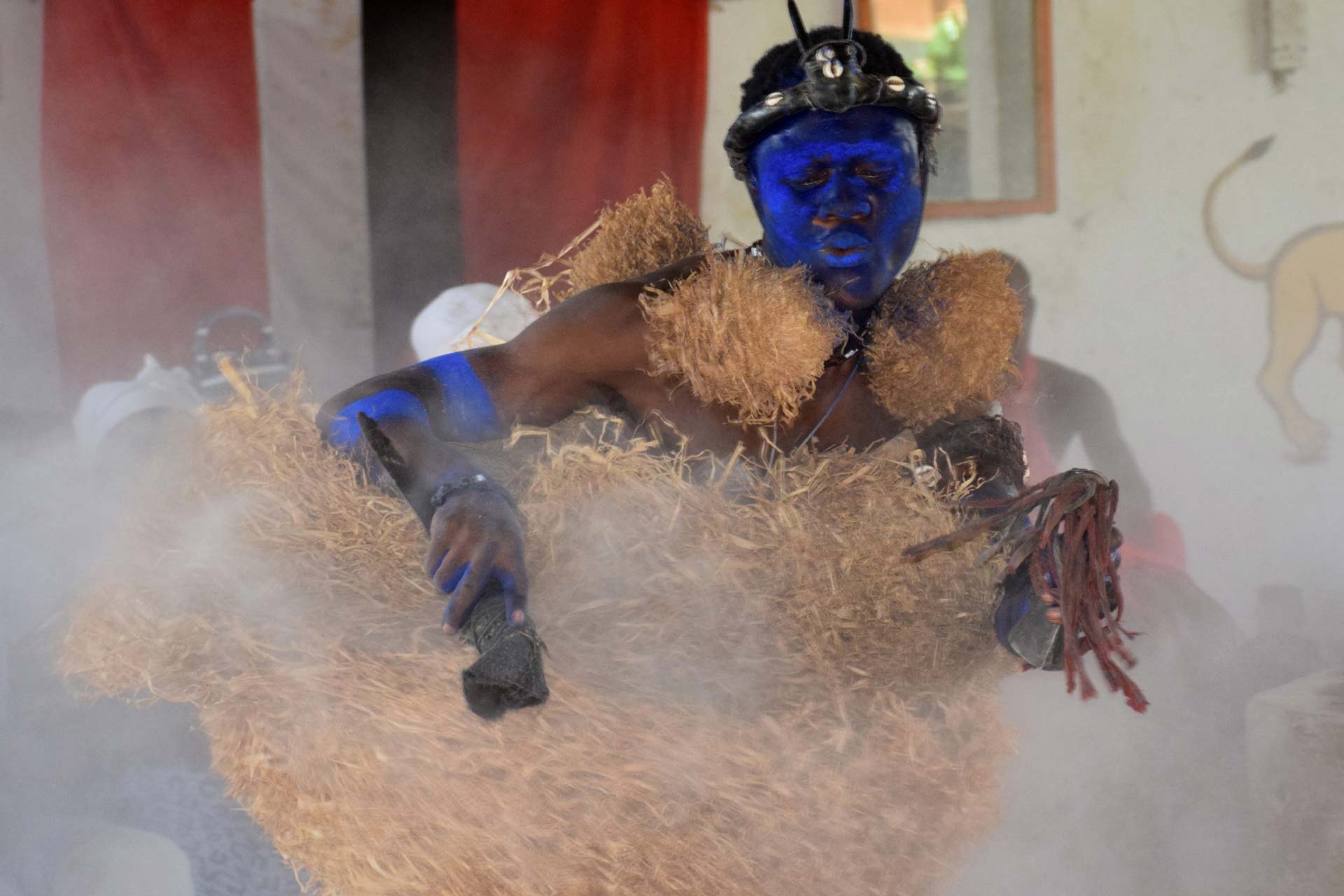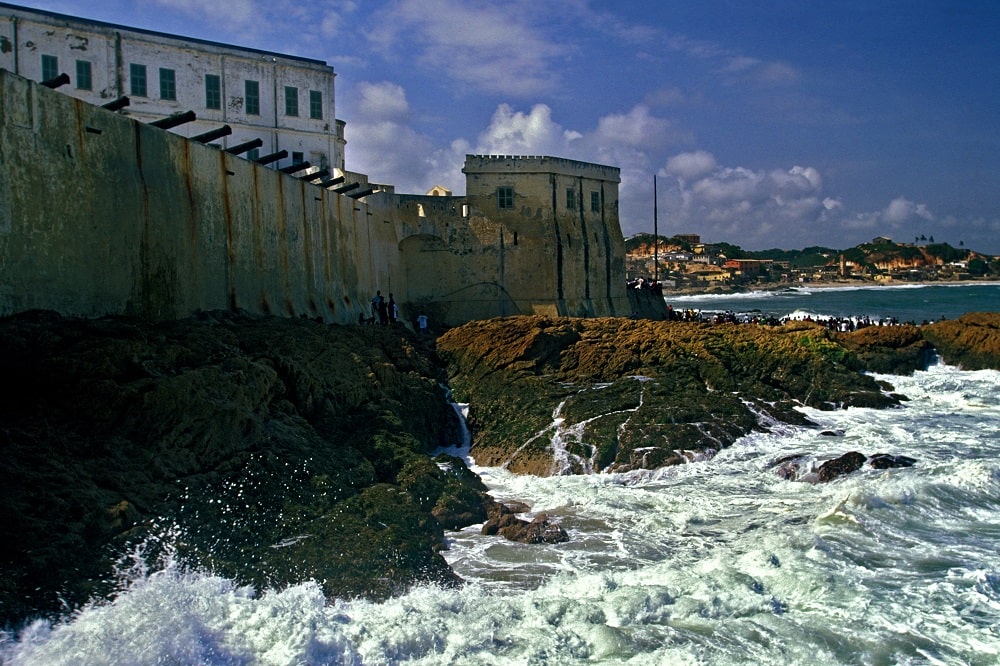Description
GHANA
Join our 13-day adventure to the heart of West Africa through an expedition-like journey across Ghana, a country which is incredibly rich in traditions and yet is experiencing ever increasing modernity.
A trip for travellers in love with timeless West Africa, variety of landscapes and tribes, local markets rich in colours, spices, and smells, frenetic yet delicate rhythms, rituals and dances.
Who are interested in the uniqueness of the Ashanti traditional ceremonies.
We visit the castles which served the slave trade.
We satisfy our hidden curiosity about witchcraft: we will visit a village entirely inhabited by witches!
Special events: a royal festival in Ashanti kingdom and an intriguing voodoo ceremony.
In the north we will walk in one of few National Parks in West Africa, which deserves a visit. Mole Park.
A tour mixing people and nature; history and present. With an eye to Africa building its future: Accra, one of the most vibrant cities in Africa.

DAY 1: Accra, Gulf of Guinea
Arrival in Accra (Ghana) and transfer to the hotel.
DAY 2: African Metropolis, from Accra to Anomabu (160 km – driving time 4 hr)
Accra, the capital of Ghana, has maintained its unique identity despite the fast-paced development currently underway in this intriguing African city. The luxuriant administrative area, punctuated with elegant villas built during the first half of the 19th century, reminds us that Ghana was one of the most flourishing British colonies in West Africa.
Facing the Ocean is where local native people life fully unfolds: a village surrounded by the city! Here all economic activities follow very different rules from the ones governing “the city” (business area), just a few hundred meters away. Our tour continues with the visit of a workshop where they specialize in building fantasy coffins. These special handcrafted coffins can reflect any shape: fruits, animals, fish, cars, airplanes…. the only limit being imagination! Started in Africa, these flamboyant coffin designs are by now collected worldwide and exposed in museums.
Drive to Anomabu.
DAY 3: Slave trade castles, from Anomabu to Kakum – Elmina – Anomabu (170 km – driving time 3 hr)
In the morning, we will experience the thrill of a “canopy walk” right in the deep forest of the Kakum National Park: one of the world highest suspended rope bridges held by steel cables. Perched 37 meters (120 feet) above the earth, you will enjoy a stunning view of the rainforest. Instead of unveiling their trunks, trees will reveal their tops!
In the afternoon visit of Elmina Castle, the oldest European building in Africa, erected by the Portuguese in the 15th century. At different times the castle has been used as a warehouse to trade gold, ivory, and eventually slaves. The castle we visit today is the result of successive extension works and is recognized as a UNESCO World Heritage site. The old Dutch Cemetery in Elmina goes back to 1806. Outside the castle, a wonderful fishing village with lots of large colorful fishing boats – every day these canoes are guided by skilled fishermen across strong ocean waves and currents, “fighting” to earn a living. The alleys in the old town have a very lively atmosphere, bringing us back to a time when Elmina was a busy colonial town.
In a neighbour town we will discover the Posuban, shrines of the Asafo companies where the Asafo warriors still pour libations.
DAY 4: Ashanti, from Anomabu to Kumasi (250 km – driving time 5 hr)
Late morning arrival in Kumasi, the historical and spiritual capital of the old Ashanti Kingdom. The Ashanti people were one of the most powerful nations in Africa until the end of the XIX century, when the British annexed Ashanti Country to their Gold Coast colony. The tribute paid today to the Asantehene (=King) is the best evidence of their past splendour and strength. With nearly three million inhabitants, Kumasi is a sprawling city with a fantastic central market, one of the biggest in Africa. Every type of Ashanti craft (leather goods, pottery, Kente cloth) is found here, along with just about every kind of tropical fruit and vegetable.
The program includes a visit to the Ashanti Cultural Centre: a rich collection of Ashanti artifacts housed in a wonderful reproduction of an Ashanti house.
In the afternoon we participate – if available – in a traditional Ashanti funeral, attended by mourners wearing beautifully red or black togas. We say “funerals” but it means a “festive” celebration: the deceased in fact is believed to be still with his/her family and through this ceremony he/she becomes an ancestor. Relatives and friends gather, socialise, and celebrate his/her memory. The chief arrives surrounded by his court under the shade of large umbrellas while drums give rhythm to the dancers whose intricate moves are highly symbolic.
Swinging Africa: optional night city tour, live bands, high-life and local contemporary music.
DAY 5: Golden Kingdom, from Kumasi to Techiman (130 km – driving time 3 hr)
On a Sunday morning, Kumasi wakes up slowly and the streets of the city, not too busy, become like a charming and interesting stage to any curious traveller: the colonial buildings around the market, the very original hand-painted advertisement signs (real urban art!), the railway lines crossing the central market, the devotees going to church in their Sunday clothes – so out of fashion to actually be of great fashion!
We will visit also the Royal Palace Museum, hosting a unique collection of gold jewels worn by the Ashanti court.
Akwasidae Festival. On the Ashanti calendar certain days each year are set aside for a very special celebration at the Royal Palace in Kumasi and this traditional ceremony takes place in one of the last African Kingdoms which has maintained its ancient rituals still alive.
During this celebration, the King sits under a spectacular colourful umbrella, is adorned in vivid cloth and massive centuries old jewellery (Ashanti gold jewellery and masks are considered masterpieces of African art) and is surrounded by the Ashanti elders and advisors, all under the authority of the Royal Speaker who holds in his hands the symbols of power. In front of the King a narrow passage of dignitaries is also formed, representing all roles and positions of power within the kingdom: sword and knife bearers, armed guards, carriers of beautiful ostrich feathers fans etc. The ceremony is then made up of a procession of royal court attendants bringing gifts, storytellers reciting the history of the Ashanti Kings, drummers & trumpeters playing horns of ivory. Corpulent dancers dressed in vivid red costumes perform an erotic dance. The mother queen also joins the ceremony accompanied by her attendants. We will witness and experience the splendour, the flavour and the atmosphere of one of last great African monarchs of the forests.
In the afternoon transfer to Techiman
DAY 6: to Savannah, from Techiman to Mole (330 km – drive 6 hr)
After a long transfer we reach Mole Reserve.
Stop to visit friendly villages and colourful markets on the way
DAY 7: Wildlife, Walking and drive safari in Mole
Mole: the largest, oldest, and most developed park in Ghana. It covers an area of 4,912 sq. km.
The vegetation is savannah woodland with gallery forest along watercourses. 734 species of flowering plants have been recorded in the park. 90 mammalian species including elephant, buffalo, roan, kob, hartebeest, water buck, reed buck and other antelopes.
Among the estimated 500 elephants found at the Mole National Park are three relatively “tame” individuals.
Because of the good protection given to animals in the park, the elephant have generally become used to visitors and allow them to get close during the guided tours of the Park.
DAY 8: Thatched roofs, from Mole to Yendi (250 km – drive 5 hr)
Further to the Northeast, in the savannah, we meet the Dagomba, a tribe that represents one eighth of the entire Ghanaian population. They are mainly farmers and have always shared their territory with other tribes such as the Konkomba. They build round clay huts with thatched roof. The house of the village chief, where the council of the elders meets, is easily recognizable thanks to its larger size and style: it has a central pole supporting the roof and the entry is framed with pieces of burned clay.
DAY 9: Witches, from Yendi to Nkwanta (180 km – driving time 4 hr)
We meet a very large settlement of … witches! All exiled from their villages because found guilty of terrible events such as the death of a teenager, a mysterious disease, or a bad harvest…they now live all together in a specific place. We will chat with them about their life and about the special shrine which protects them, “cleansing” their spirit from bad will. Their warm welcome is in dramatic contrasts with the gravity of the stories that forced them to come here.
DAY 10: Waterfalls, from Nkwanta to Wli (180 km – drive 4 hr)
Volta Region: from Savannah to tropical forest. Visits of coffee and cocoa plantations in a luxuriant region; stops in small villages inhabited by a very friendly population, happy to welcome the rare visitors. We will discover the beautiful Wli Waterfalls, on the border with Togo, where water falls from a height of 60-80 meters. The walk to reach the falls, is approximately 45 minutes (nice flat path) and it will allow us to sight some of the 200 species of birds and the 400 species of butterflies which have been identified in the region.
DAY 11: Green Land, from Wli to Akosombo (140 km – driving time 4 hr)
We drive to the Volta Region.
The Monkey Sanctuary of Tafi Atome was created in 1993 to protect a community of sacred monkeys living in the forest. According to century-old traditions, in this village monkeys and tortoises are considered sacred species thus demanding respect and protection. Monkeys are the “spokesman” of tortoises. We will take a lovely walk in the forest lead by a local guide to encounter this great community of Monas and Colobus monkeys.
Amedzope: the highest located village in Ghana (756 m.). We reach the village by a winding road running through a green forest. We enjoy the view on the valley.
DAY 12: Voodoo: Akosombo region
We attend a Voodoo ceremony: the frenetic rhythm of the drums and the chants of the adepts help calling in the voodoo spirit who then takes possession of some of the dancers. They fall into a deep trance: eyes rolling back, grimaces, convulsions, insensitivity to fire or pain. Sakpata, Heviesso, Mami Water are just some of the voodoos divinities who can show up. In this narrow village, surrounded by the magic atmosphere of the ceremony, we will finally understand what people mean when they say: “In your Churches you pray God; in our voodoo shrine we become God!”
Voodoo is a religion that has been passed on by the ancestors and is still fervently practiced. Although for many Europeans voodoo is only a vulgar form of black magic, in truth voodoo is a true religion, far richer and more complex than people often think.
The area of Krobo is famous all around the world for its beads. Here they are produced and used for cults and aesthetic purposes. We will visit a factory specialized in the production of those beads and even follow the process of making your own bead!
The craftsmen have now been making beads following the same long lasting traditional technique for centuries. They use scrap glass that they ground into a fine powder. The glass powder is then meticulously made into patterns and placed into hand-made clay moulds covered in kaolin. The beads are cooked, then decorated, washed, and eventually strung.
DAY 13: Accra out, from Akosombo to Accra (100 km – driving time 3 hrs)
Drive to Accra.
Today we focus on the very modern soul of Accra.
Transfer to the airport for the flight out































